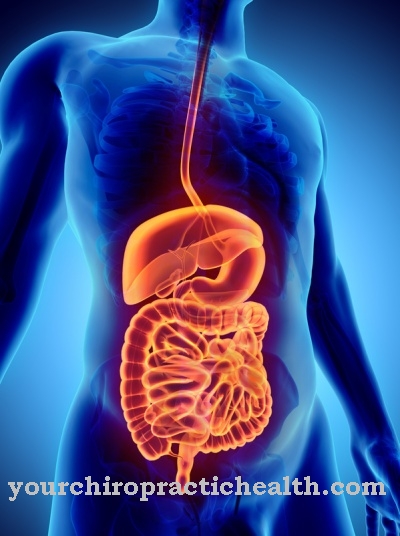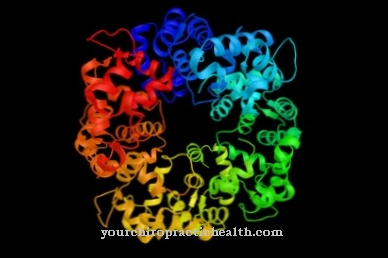The Cytotoxicity indicates the degree of toxic effects of chemical substances and living cells on the body's cells. Their influence damages or even kills the human cell. Many different processes lead to the destruction of body cells.
What is the cytotoxicity?

The term cytotoxicity is derived from the Greek and means cell poison there. Many substances are toxic to the body's cells, some of which can even kill the cells. There are many chemicals that can interfere with the metabolism of cells and change it in the process.
Chemical cell toxins include certain organic acids, hydrogen peroxide, and ethanol (alcohol). Many dangerous substances are also known from everyday life, such as inorganic acids, highly concentrated alkalis, chlorinated hydrocarbons and many more. Many biological poisons are also known. Snake poisons, mushroom poisons and many other plant and animal poisons have cytotoxic effects.
In the process of evolution, new cell toxins were created. They serve in part to ward off attacks and in the context of hunting to kill the prey. However, not only chemical but also biological cytotoxics have developed.
To ward off infections, the immune system has developed a sophisticated system of defense against bacteria, fungi and viruses. Not only do the cells of the microorganisms themselves have to be killed, but also the body cells they attack. Therefore, cytotoxics also include T cells, natural killer cells, neutrophils and macrophages.
Function & task
The cytotoxicity of certain substances and cells is of great importance in the context of biological development. The immune system in particular has developed some strategies to protect the body from microbial invaders. These include bacteria, fungi and viruses. Infected cells further damage the organism and have to be killed by the defense mechanisms of the immune system.
Even before they enter the body, bacteria are confronted with various antibodies and in some cases killed. If this first immune reaction is sufficient to stop the bacteria from entering, the production of cytotoxic substances and immune cells against the bacteria ends here.
Infected body cells, however, have to be eliminated through the influence of T cells, natural killer cells and macrophages. The organism also produces antibodies that combine with antigens on the cell surfaces. In these cases the cytotoxic effect of the immune cells and antibodies serves the health of the whole organism.
The fight against viruses can only work by destroying the infected cells. Violent inflammatory reactions develop, which are noticeable in pain and fever. The entire disease process in the event of an infection can be understood as a cytotoxic reaction.
When using medicinal products, the cytotoxic properties of the corresponding substances are often used. Often these are cytostatic effects to kill specific diseased cells in the body. This is especially true for tumor cells that divide indefinitely.
Cytostatic agents often mediate their cytotoxic effect through their influence on nucleic acid production. For example, if the formation of nitrogen bases is inhibited, cell growth comes to a standstill due to insufficient nucleic acid production. This mainly affects rapidly growing cells such as tumor cells. Therefore, the effects of these drugs, which are used as part of chemotherapy, are specifically directed against cancer cells. The side effects are based on the simultaneous slowdown in the growth of mucosal and immune cells.
Illnesses & ailments
However, cytotoxins do not only have positive effects. There are many biological agents that can kill all body cells and thus the death of the entire body.Examples are snake poisons, mushroom poisons and many other plant and animal poisons. For the poison-producing organisms this means a biological advantage over the damaged organisms. Furthermore, there are many chemical substances that have a cell-damaging effect by interfering with the cell's metabolism. Some cell poisons already have a destructive effect on cell membranes. Still other poisons inhibit the nucleic acid metabolism and thus lead to the destruction of the cell.
The mechanisms of action are very broad. The cytotoxicity can be shown using a cytotoxicity scale. There are gradations from 0 to 3. At 0 the substance is non-toxic. At level 1 there is a slight inhibition by a slightly toxic material. Level 2 again means a significant inhibition by moderately toxic material. Highly toxic materials are counted at level 3.
The cytotoxicity of a substance can be determined by the so-called cell viability. Cell viability represents the number of living cells in a cell population. The fewer living cells there are, the lower the cell viability and the more toxic the substance being examined for toxicity. The total number of cells is determined using a counting chamber or a flow cytometer, among other things. The living cells can then be identified using certain staining methods. This method can be used to determine the concentration of a substance in which cell viability is reduced by 50 percent. This is then the IC50 value. At this concentration, 50 percent of the cells die. The effectiveness of chemotherapeutic agents or disinfectants can be estimated using this value. If the IC50 value is exceeded when using these agents, the toxicity outweighs the entire body. Significant health impairments occur, which can also lead to death.
























.jpg)



